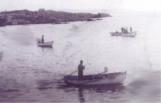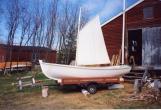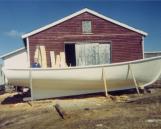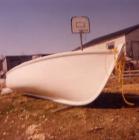14
In sketch #6 we depart completely from the boat types of the other five sketches. Here we have a sketch of the dory. She's fourteen feet long with a midship room that is four feet four inches wide. Note the shape of her counter. Note, too, that the bottom is not flat. Rather it is raised three inches aft and three and a half inches forward from the level position. She could be sculled with a sculling oar (note the sculling crevice in the counter's top) or she could be rowed with paddles. This little dory would be quite suitable as a go-ashore from a bigger boat left at anchor some distance from the shore.16
The punt in the forefront of this picture was the first boat built by Samuel Feltham, age fifteen. It took approximately one month to complete. It measures seventeen feet long, four feet eight inches wide and twenty inches deep.Most Deer Island families had a punt which, typically, carried a sail so that, when the breeze was powerful enough, the power of nature could do the work of the rowers and give them a break. Punts were used for hauling nets and trawls, for hook and line fishing, for traveling island to island or island to mainland and, as in this picture, for squid jigging.
17
Dory built by Samuel Feltham1975
Rocky Bay Island, Bonavista Bay, Newfoundland & Labrador, Canada
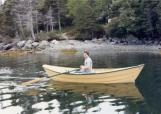
18
This dory, shown here near Rocky Bay Island in Bonavista Bay was built in less than two weeks. It measures thirteen feet in length, four feet two inches in width and fifteen inches in depth. Note that it is clinker-built as opposed to edge-to-edge built. It carries a double set of thole pins to accommodate two sets of paddles.19
Cabin Cruiser 'Low Tide' built by Samuel Feltham1972
Rocky Bay Island, Bonavista Bay, Newfoundland & Labrador, Canada
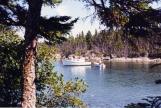
20
It took approximately six months to build this cabin cruiser. She measures twenty-four feet in length, eight feet in width and thirty-four inches in depth.She was called 'Low Tide' to mourn a political event. She was built during the period when Liberal Premier Joey Smallwood resigned (1972) so, from a Liberal point of view, the political tide was low. Joey probably inadvertently prompted the name when he said, "The Liberal tide has gone out."
21
Cabin cruiser 'High Tide' built by Samuel Feltham1989
Alexander Bay, Glovertown, Newfoundland & Labrador, Canada
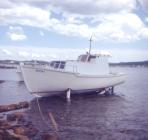
22
The 'High Tide' measures twenty-two feet in length, eight feet in width and three feet in depth. She was built in 1989 when Clyde Wells brought the Liberals back to power in Newfoundland and Labrador. Samuel Feltham named his cabin cruiser to celebrate the Liberal return.Incidentally, it might be important to point out that cabin cruisers, very popular in Central Bonavista Bay, are used primarily for pleasure - going out the bay for a weekend of fun and relaxation, taking friends for a ride, mussel collecting, trouting and other pastimes.
24
This little rodney, or small punt as some would call her, was built in three weeks. She measures thirteen feet in length, four feet two inches in width and eighteen inches in depth. [Rodneys generally don't go longer than fourteen or fifteen feet]. This one was built as a sailing boat. Typically, such boats are used by one man for hook and line fishing, for squid jigging, for traveling settlement to settlement to shop. The norm was one sail, one set of paddles, one sculling oar. When towed behind a larger boat as a convenience in going from the larger boat to shore, a rodney was called a go-ashore.26
This scaled-down trapskiff was built in less than three months. Samuel Feltham used the moulds for his regular trapskiff but shortened the length to give the boat less weight, more flexibility and faster speed.After the invention of the codtrap in the late nineteenth century, trapskiffs became the most popular of fishing boats, the first lot being powered by sails which were quickly, in the early twentieth century, replaced by marine engines.
